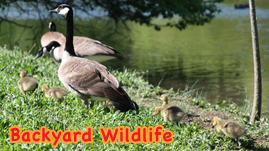Teachers' Domain - Digital Media for the Classroom and Professional Development
User: Preview


KET's Everyday Science is funded in part by Kentucky Power and the American Electric Power Foundation and PNC Bank.
Take a field trip in your own backyard. Who shares that space with you? What do they eat? Where do they live? Backyard Wildlife, an original KET video, introduces children to animals they might find just outside the back door or in a nearby park.
This resource is part of the KET Everyday Science collection.
Everyday Science: Backyard Wildlife Interactive (Interactive)
Kids like animals. Encouraging children to notice the different animals they see is an easy way to introduce them to one of the most basic scientific concepts, observation.
Even young children can draw pictures of animals and in so doing come to a better understanding of certain distinguishing features. Frogs are green. Birds have feathers. Squirrels have fur and long tails.
Older children can draw or take photographs of the animals. They can read to learn more about them. Are all squirrels gray? What kind of birds live in my area? Why are some frogs smaller than others? How are ducks and geese different?
Children can begin by exploring the world they find closest to home, in their own backyard.
The Teaching Tips will give you some ideas how to continue the conversation and expand on the content in the video.
Vocabulary
fur, feathers, scales, paws, claws, reptile, mammal, fish, turtle, Canada Goose, squirrel, chipmunk etc.
 Loading Standards
Loading Standards Teachers' Domain is proud to be a Pathways portal to the National Science Digital Library.
Teachers' Domain is proud to be a Pathways portal to the National Science Digital Library.
